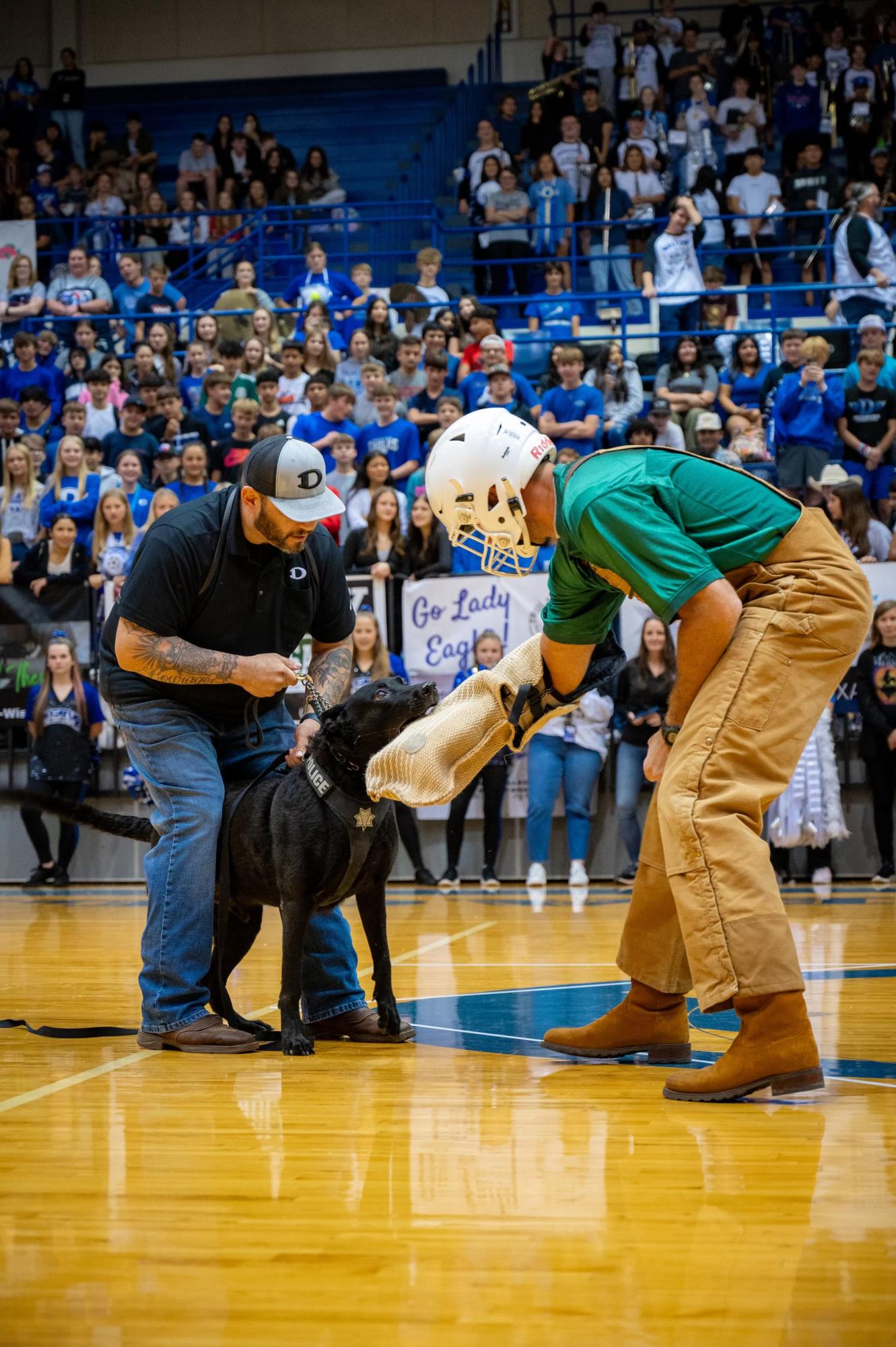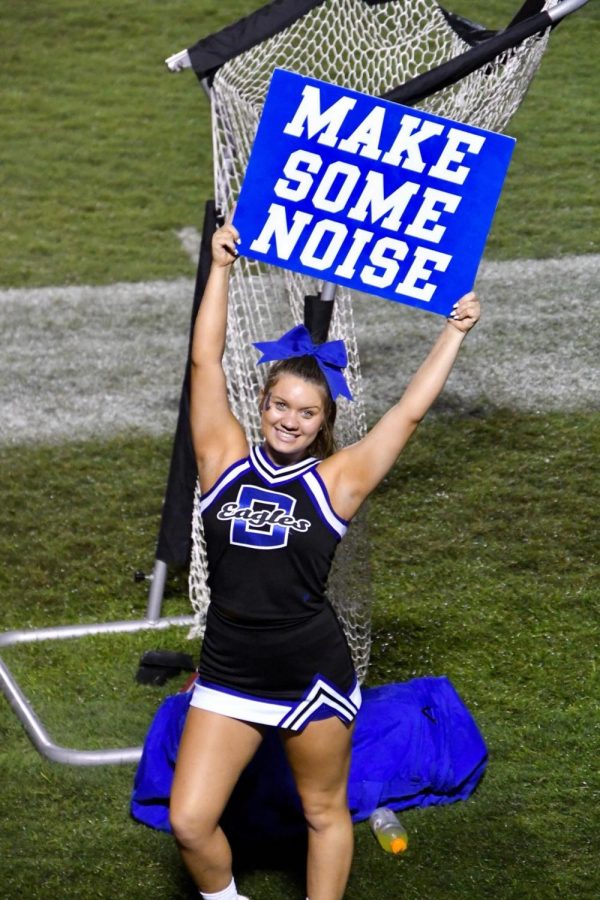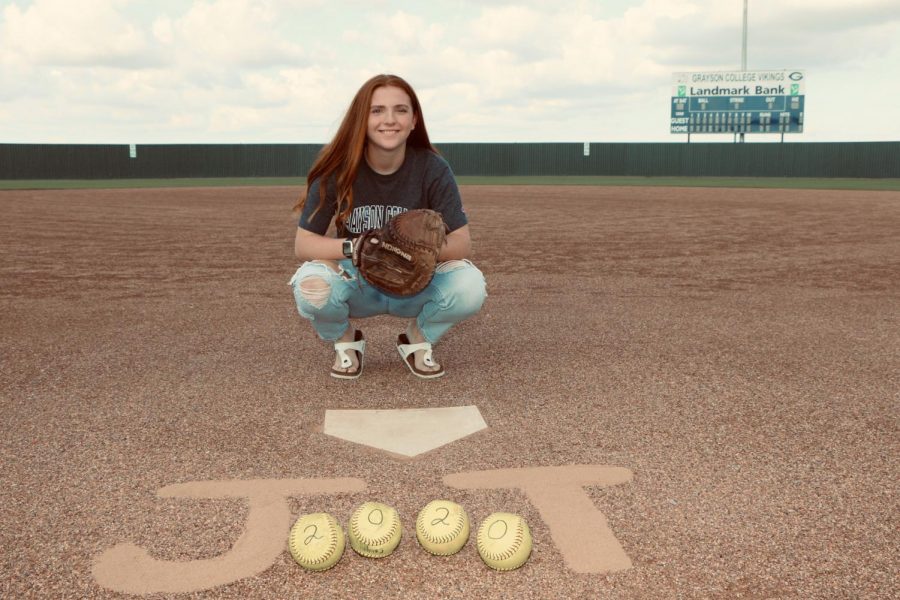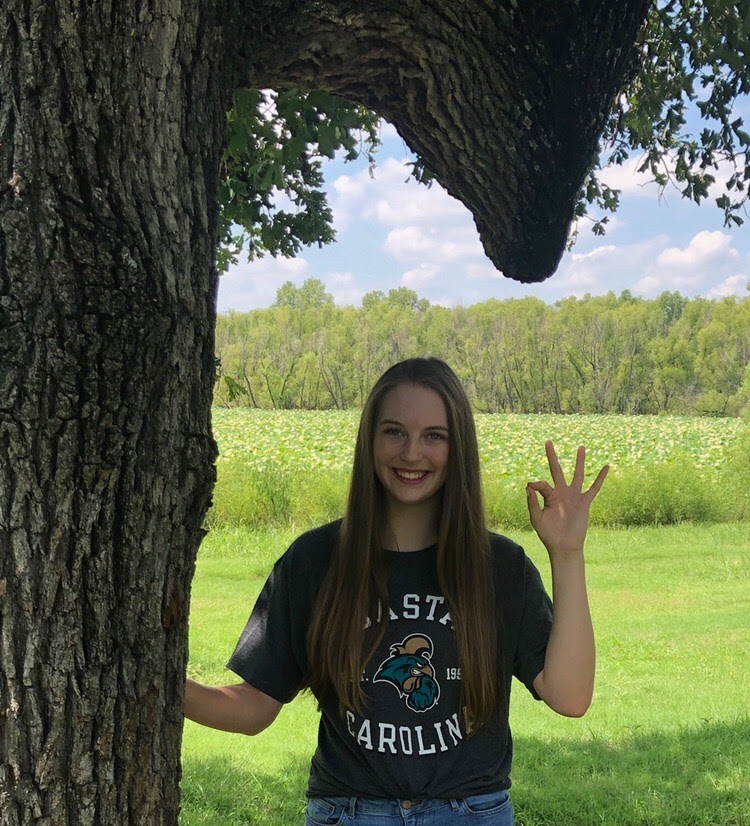Law enforcement teacher, Mr. Garcia, is a retired police officer who often brings his retired police dog, Gator, to school. He shows Gator around his classroom and in pep rallies, and has him interact with his students.
Mr. Garcia and Gator, an eight-year-old Belgian Malinois, arrived in Texas from California around December 2021, and started working for Decatur High School in August of 2022.
Mr. Garcia re-named his K-9 to Gator because of the fact that Belgian Malinois have big mouths, like an alligator. Originally, the city named him Vader. The name was a play on a famous character, Darth Vader.
Gator was born in North California, but his parents came from the Netherlands. As a result, Mr. Garcia said that Gator was taught to listen to commands in Dutch, as that was the origin of his parents. Dutch is one of the most common languages for police K-9s to be trained in.
“Gator trained in Dutch,” Mr. Garcia said. “That’s his language and gait but Gator was born in Northern California by his working dog line. And that’s where I barricaded around was in the Bay Area in California.”
According to Mr. Garcia, the reason he got a canine when he was a police officer was because of the opportunities it provided, for his current job position.
“I was a watch commander, but then I also wanted to run a canine,” Mr. Garcia said. “To run a police canine you have to be on the force, usually for a minimum of five years, and have some experience.”
Mr. Garcia’s experience from being a police motorcycle officer, supervisor, and field training officer, got him the opportunity to start running Gator.
“When they offered me to run the police dog, I took that opportunity because it’s a huge, huge opportunity for us to get a promotion to do something else, into a specialized unit,” Mr. Garcia said. “And that’s how I ended up getting Gator.”
The former police officer describes the initial process of getting Gator as being paired together by the police department.
“So for us as handlers, I don’t train Gator when we get them,” Mr. Garcia said. “The police department buys the puppies, and then they have them trained. And so the police department chose Gator and then they chose me to be his handler. And then we were sent off to training for six weeks together, so that we can actually work together.”
In the early stages of training, Mr. Garcia had to get to know Gator’s personality before they could begin the actual training. By getting to know each other better, they became more familiar, and the two easily transitioned into being a team. Then, when the real training began, the two could bond through shared and tough work experiences.
“It was pretty intimidating. Gator came up and he jumped on me, and I didn’t realize how big Gator was gonna be.”
However, the bond between the police officer and canine grew the more they worked together.
“As we started working together, he started listening to me more and more and becoming more compliant. Then we built that bond as if I was his dad.”
Although Gator was chosen for him, Mr. Garcia said that police officers and K-9s work as a singular unit.
“We’re attached to them,” Mr. Garcia said. “We’re joined as a team.”
They were not only a son and dad relationship, but having good teamwork and communication skills were necessary, as they were also responsible for the lives of citizens.
The training with Gator as a canine team, consisted of honing in on specific skills.
“Tracking for suspects, looking for drugs, tracking for weapons, and then of course Gator’s a dual purpose dog, so that means that he’s an apprehension dog,” Mr Garcia said. “[And] Honing in on odor work, which is locating drugs. And that’s for a total of six weeks.”
Gator was trained as an apprehension dog, which primarily focuses on biting suspects. However, apprehension dogs are also keen to use their sense of smell for objects, substances, or suspects.
Training Gator to be more obedient and to listen to commands, caused a gratifying experience for both of them.
“It was more pleasurable to be around him because we weren’t tripping over each other,” Mr. Garcia said. “…We formed a very, very effective team.”
According to Mr. Garcia, a dog’s breed and bloodline can often determine whether a dog becomes a police canine.
“A lot of times it has to do with the breed of the dog and it has to do with the working line, the line of the dog, the actual DNA of the dog, the bloodline,” Mr. Garcia said.
One of Mr. Garcia’s examples is a chihuahua, they may have a good bark but not as good of a bite, nor size.
“And so if the dog came from a working dog bloodline, that’s typically what people are looking for,” Mr. Garcia said. “Once the dog has that in them and they’re a good working dog, It makes the trainer’s job a lot easier, to mold the dog the way they want them to be for police work or military work.”
An example is a farm-dog or a shepherding K-9, as it’s easier for them to transition into this line of work from their prior one.
Then, to go out on the street as an official canine dog, the dogs must go through rigorous training and tests to qualify.
“Once they get the dog, they run the dog through a series of tests,” Mr. Garcia said. “We check in to make sure that the dog is comfortable on slick floors, so like on tile floor, we squirt it with water to see if they’re afraid of water.”
Due to the strict rubric K-9s have to face to meet the requirements, they have to work through a selection of courses before they pass. These tests may include things like seeing how the dog reacts to gunfire, or how they behave in potential situations they may face.
“So if the suspect’s holding a bicycle, or they’re gonna get afraid, there is a lot of yelling to distract the dog to see if the dog’s gonna be distracted,” Mr. Garcia said. “So there’s a variety of tests that the dog have to go through to pass, before they even are able to go on the street as a police dog.”
Although Gator is very good at following instructions, he can still mess up from time to time. The trainer uses specific tools and commands that don’t especially hurt the dog, but corrects them. For instance, Mr. Garcia sometimes has to use a shock collar around his neck, which sends a signal to Gator’s brain that what he is doing isn’t right.
This method may be used in certain situations, like when Gator doesn’t let go of a suspect or isn’t behaving to commands.
“We have their collars and leashes that we use to help us correct them if they’re doing something they shouldn’t be doing,” Mr. Garcia said. “So just like any other dog, they have all kinds of different commands that make them bark, commands that keep them quiet, and commands that have them search.”
Whilst Gator was a big help to the community as a police canine, Mr. Garcia recalls their unbreakable bond. This is due to the fact that Mr. Garcia and Gator have been partners for many years on the streets, and it’s a relationship that most people don’t get with house-pets.
“…I cannot even begin to ask people… ‘would you send your dog after a suspect knowing that there’s a chance that your dog might not stay alive?’” Mr. Garcia said. “But it’s the same with us as police officers when we leave our families. Sometimes we don’t know if we’ll come back home that night or not.”
Although they are both risking their lives for others, it is still hard for any K-9 police officer, to willingly put their partner in trouble’s way.
“It’s one thing to have a companion and love your dog,” Mr. Garcia said. “But it’s another to have to make a hard decision to leave every night with your dog knowing that one of you may not come back home. And that’s where you have to have a high level of emotional intelligence to be able to do that and to be able to be a canine handler, because it’s not for everybody.”
Although Gator was Mr. Garcia’s partner in his work, Gator was also his personal dog, so the health issues that arose with the K-9 hit hard at home.
“[Gator] did very, very well early on as a police dog and didn’t have any complications,” Mr. Garcia said. “But unfortunately, over the last couple of years, June of 2022, Gator was diagnosed with bladder cancer.”
It may not be a happy memory, but it’s an obstacle both Gator and Garcia have managed to overcome.
“…I was told that he had a mass that was growing on his bladder, and that mass was actually cancer related,” Mr. Garcia said. “When they advised us that it was a cancer mass, we had to look for medication to help him with that. And when we were initially going through the process, they said Gator only had a couple of more months to live. So he was supposed to have passed by August of 22.”
Mr. Garcia explains how his tight-knit bond with his dog had impacted him emotionally, as losing Gator would be like losing a family member.
“It was really hard for me but I took it,” Mr. Garcia said. “It was very emotional, but I tried to do my best to make sure that you guys, especially students here last year, didn’t see that.”
As both police officers and partners, Gator would always protect him, so Mr. Garcia wanted to repay the favor by searching for possible cures for Gator.
Fortunately, Mr. Garcia was able to find a company in California that would be able to treat Gator.
“Fido Cure provides this medication specific to dog cancer, and it was able to actually cure his cancer,” Mr. Garcia said. “So he is in complete remission now, and we’re over a year into it. So he’s doing great and there are no signs of the cancer as of today.”
Gator is no longer suffering from cancer anymore, so he’s able to show the crowd a good time at pep rallies and in Mr. Garcia’s classes.
Mr. Garcia didn’t bring up the idea to have Gator be an event in pep rallies, but instead Mrs. Bayless suggested it.
“[Mrs. Bayless] asked if Gator would be willing to come out and participate in the pep rally,” Mr. Garcia said. “And I said, ‘what are we thinking? Like, what type of process are we thinking? How’s his involvement going to be?’ And she said, ‘well, I was thinking maybe he can bite somebody.’”
Mr. Garcia trusts Gator to behave appropriately in certain situations and environments, which is why Gator became a part of the pep rally.
“When we’re in an environment where I’m asking Gator to bite or apprehend somebody, even if it’s at a pep rally, he will go based off of my commands that I give him in Dutch,” Mr. Garcia said. “I felt very comfortable knowing based off of all of our experience that Gator would know when to bite, and when to release, so that we can provide a nice entertaining show for you guys.”
Mr. Garcia says that the event in the pep rally is pretty similar to typical training and behavior for a police canine.
“He’s been trained that way,” Mr. Garcia said. “That’s pretty much a typical training for us. So like if we went to our regular police training, we would have what we call as decoys which are helpers that would wear the sleeves or wear the big puff suits to bite suits. And so Gator is very used to it and familiar with it. So he just looks at Mrs. Bayless, her husband as being a decoy.”
Although having an experienced police canine like Gator biting someone might be dangerous, in this situation where Mrs. Bayless’s husband wears a suit and a canine sleeve, it’s both safe and entertaining for the students.
“And then you know when it’s time for us to work, especially at the pep rally in his mind, that’s work time…,” Mr. Garcia said. “So he just gets really excited and you can look at his little face on the photos. He’s looking at Mrs. Bayless her husband, right directly in the eyes and he just loves it, because he thinks he’s playing. That’s his toy.”
Mrs. Bayless, an English teacher at Decatur High School, shares her side of the story when adding Gator to the pep rallies, alongside the background behind her husband getting “bitten” by Gator.
“Okay, so it all boils back to whenever I met Mr. Garcia – Officer Garcia – for the first time, last year…” Mrs. Bayless said. “He had mentioned his history as a police officer. They moved from California, he has a canine, and I’m fascinated by canines. I think they’re so incredible.”
Mrs. Bayless and Mr. Garcia spoke for a while about Gator, and what it was like to be a police officer, and being on duty with a K-9 as your partner. This led to Mrs. Bayless and Mr. Garcia’s fun idea to have Gator in pep rallies, and eventually it turned into a recurring event.
“After doing it last year, it kind of just needs to be a tradition,” Mrs. Bayless said.
Mrs. Bayless said that they need to continue this trend in the pep rallies, as Gator is a part of the Decatur eagle family. Gator being at pep rallies and at school, can make the world a difference when coming every day to class.
“It’s really cool to see that, and I think that Gator is such a cool example for us all,” Mrs. Bayless said.
At first, Mrs. Bayless’s husband, Nate, wasn’t the first obvious choice. They had originally planned to choose a staff member.
“We were gonna ask a staff member and Chef Goodmay was the one that was like, 100%,” Mrs. Bayless said. “‘I’ll do it.’ He still would do it. But Mr. Lackey was a little bit nervous having anybody on campus do it. And I just said I’ll volunteer my husband and my husband – he doesn’t care.”
Fast-forward to right before the pep rally, Mrs. Bayless describes her husband’s interactions with Gator and Mr. Garcia.
“About 30 minutes before the pep rally started, Garcia and my husband would put the sleeve on him and he kind of would lock Gator on him,” Mrs. Bayless said.
Gator, who has been trained to specifically bite people with the sleeves and bodysuits on, was double-checked by Mr. Garcia and Mr. Bayless that he would target the right person.
“For Nate, my husband who has never been bit before, for safety reasons he wanted to make sure Gator knew exactly where to go, who to lock in on,” Mrs. Bayless said.
During the pep rally, everything went smoothly according to Mrs. Bayless. She didn’t feel particularly nervous for her husband, because seeing Mr. Bayless being excited and confident made her feel better about Gator’s event.
“Because officer Garcia had just emphasized how well-trained Gator is,” Mrs. Bayless said. “And he had the right equipment to protect his arm. And between officer Garcia’s expertise and then my husband’s just willingness to do it, I knew like it would probably be okay.”
Mrs.Bayless had seen Mr. Garcia let students from his law classes join Gator’s event and help him during it, such as holding onto Gator’s leash while he bit Mr. Bayless.
“Garcia… would always bring someone in from his law classes to help…” Mrs. Bayless said. “He would pull different people from his law classes to help him because they are just more familiar, and Gator’s comfortable with them because he spends time with them.”
Mr. Garcia said that Mrs. Bayless helped out a lot in pep rallies, and her husband, alongside three other law students.
“Mrs. Bayless, she helped out a lot, and then I had a couple of students that I trusted: Zoey Hall and then Olivia Nordstrom both helped me out with Gator, [and] Connor Skelly because they’re very familiar with Gator,” Garcia said.
Due to Mr. Garcia often bringing Gator around the school and in his classes, his students have grown comfortable around the K-9.
“They’re always around in my class with me so they felt very comfortable with assisting me as far as like getting his leashes when we dropped his leash,” Mr. Garcia said. “And, you know, as I would walk away, you would see them collecting the gear, they knew exactly what I needed from them.”
Law student Zoey Hall participated in Gator’s event, holding the leash behind Mr. Garcia. Zoey said she was chosen because she is in student council, and was already helping out on the gym floor, so it was convenient for her.
Her main role during Gator’s part of the pep rally was to make sure Gator bit the target person, pulled off the bite, and make sure the leash didn’t get stuck anywhere.
“Normally we keep him pretty far from people,” Zoey said. “Just because he’s in his attack mode. Just really making sure that he stays on his leash and he doesn’t overreact, and we can get him off the bite is mostly the most important thing. Making sure the leash did not tie around Mr. Garcia because if that got caught on him, then he would end up on the floor, and that would be bad because we wouldn’t be able to get [Gator] off the bite.”
Zoey said that Gator brings a lot of fun to the school, especially if you’re a student in one of Mr. Garcia’s law classes.
“I think it’s a lot of fun for everybody like he enjoys it,” Zoey said. “He loves seeing everybody and sniffing around, so I mean he’s having a lot of fun, and the kids love him. They love petting him every time they bring him… So I mean, it’s a lot of fun.”
Despite most students knowing Gator as Mr. Garcia’s dog that bites, Zoey knows him on a more personal level, as she often plays around with him and cuddles with the dog in class.
“He’s the sweetest biggest teddy bear ever,” Zoey said.
Mr. Garcia says that even though Gator used to be a biting dog, and still is at pep rallies, Gator is still a friendly dog at heart.
“Even if he’s here, if he’s at home, if he’s at the pep rallies, Gator is very social,” Mr. Garcia said. “He loves being around people. He’s very obedient to me. He listens to what I asked him to do, and he really essentially makes me look good. I just steer the boat. So he enjoys the interaction. He loves the attention.”
Mr. Garcia finds that many people may think a certain way, or have assumptions, about police canines. The general public might automatically assume that police dogs are usually the more vicious type. However, at home and at school, it is a different case with K-9s like Gator.
“They’re not just vicious,” Mr. Garcia said. “Gator comes home with me. He lives with me in my family. He’ll hang out with me on the couch and come and lay at the edge of the bed and stuff, so he’s a regular dog when he’s at home.”
With Gator’s work-life balance, it is a stark difference to see him at school and interacting with Mr. Garcia’s law students, than to see Gator at work where his usual playfulness is expected to be reduced when helping his partner.
“Gator’s a very unique working dog,” Mr. Garcia said. “He’s a dog that is very social, which is sometimes uncommon, especially for working dogs. He knows when it’s time to work and he knows when it’s time to socialize. And a lot of times I’ll give him that command.”
As Mr. Lackey recognized Gator’s social ties to the students, he added the new addition of Gator’s crate in the classroom, so he can have his own corner of the school to himself.
“So thank goodness Mr. Lackey actually recently approved and we put his crate in the room, so he can come now every Friday and hang out with us,” Mr. Garcia said. “And so that’s something new that we’ll be doing. But everybody loves him, including Mr. Lackey.”
Mr. Lackey is the principal at Decatur High School, and talks about how Gator became a part of the school’s culture.
“I mean, he’s just a sweet dog,” Mr. Lackey said. “It’s interesting to see him when he’s very calm and you can pet him and he’s very lovable. But then it’s also interesting to see that side of him of when he has been trained.”
Although students are able to see Gator’s calm and lovable personality in class, it is a nice change of pace for students to see a K-9 in action after a bad guy.
“You know, you can tell why he was a successful police dog,” Mr. Lackey said. “Because he had been trained to do that. And [especially] when he goes after a bad guy. I think it’s fun to hang around a little bit at the pep rallies.”
At first, Mr. Lackey didn’t expect things to turn out this way.
“I didn’t know exactly what it was going to look like,” Mr. Lackey said. “I was a little nervous at first,
Bringing Gator to the school created a more positive environment for the students, and allowed them to find more ways to be active in their law classes.
“I think for the school I think it’s a very positive impact in that it’ll give kids a connection to Mr. Garcia,” Mr. Lackey said. “But then also it was a school pride thing. The fact that we involved him in a pep rally and then we did it again this year. And when we brought Gator out a lot of kids … got excited again, and they wanted to see that again.”
Having the ability for students to casually recognize Gator in the hallways whenever they pass by him, and having the opportunity to pet a K-9 is a unique experience for everyone at Decatur High School.
“And so it was really cool to think Gator’s had a very positive impact on our school, school pride and community,” Mr. Lackey said. “It’s just fun to see the kids, they know ‘hey Gator,’ they know who he is and they have a relationship with him, and it’s a very positive experience.”
It’s nice for students to see a canine dog in action, who represents Mr. Garcia’s law enforcement classes, however if they visit his class regularly they’ll also find a soft spot for Gator – who is more bark (when Mr. Garcia shows the class how Gator responds to Dutch commands) than bite.
“It’s fun to see the interactions with the students and how much they’ve gotten to know him… and when he shows why he was part of the canine unit and the dog Gator goes and attacks,” Mr. Lackey said. “ It’s also neat to see the Gator of when he’s calm and you can pet him and he’s most lovable dog, and so it’s just been neat to see the impact that gators had on kids.”
However, Mr. Garcia isn’t the only officer around with a history of K-9 companions.
School Resource Officer (SRO) Mr. Baker was also a part of a canine team. Steve baker has been in Decatur working in the police department since 2022, but started his law enforcement career in 1988. Mr. Baker is both a retired chief and a canine officer for seven years.
Mr. Baker thinks highly of getting young people into law enforcement as early as high school, like Mr. Garcia’s classes, including having a K-9 around like Gator.
“I had a German Shepherd,” Mr. Baker said. “Her name was Blanca. She was kicked out of the air force because she wouldn’t bite… So we just made her a drug dog.”
The reason why Gator is so professional in pep rallies and in videos was because of the thorough training dogs like him and Blanca went through to become K-9s, because a fault of the dog could fall back on their canine handler.
“It’s nonstop training, people don’t understand that,” Mr. Baker said. “…They’re not doing it because they like narcotics. They’re doing it because they like to play. They like to get the reward once they find it.”
Even though Gator is a professional K-9, he is still a dog who seeks affection and attention, and socializes with people when he isn’t working.
“The students love him because when he comes in, he’s so lovable and he’s so social,” Mr. Garcia said. “So the impact that I think he’s had not only on my classroom, but here as a whole, has been pretty mind blowing for me. I mean, it’s pretty surprising.”







